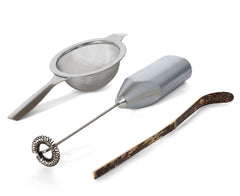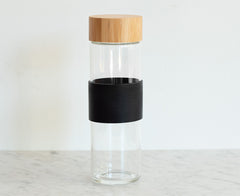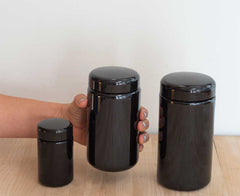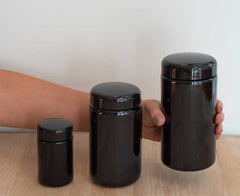One of caffeine’s biggest claims to fame is that it is the most widely used psychoactive drug on the planet (and it even happens to be legal). Morning routines throughout the globe and the centuries often center around making and drinking tea or coffee, which are caffeine’s most popular forms, respectively.
Caffeine works as a stimulant for the brain and body – and being awake and productive is often why we seek out caffeine, especially in the morning. Talking, walking, working, thinking, and just about everything else we do throughout the day get notable boosts from caffeine.
How you will feel after consuming caffeine varies with each person, and the caffeine source plays a starring role.
Matcha serves up approximately 25mg of caffeine per serving (defined as 1 gram, or a rounded half-teaspoon), which is roughly a fifth of what you get in a small coffee from Starbucks, which has about 125mg. This is by most standards a very small amount of caffeine, and it is gentle and easily tolerated by many people for whom coffee makes them jittery.
Because matcha’s components in effect slow down the release of caffeine into the body, it typically takes a good three to six hours for this minimal amount of caffeine to be fully absorbed into the bloodstream, in contrast with the caffeine in coffee, which hits the bloodstream in minutes. And yet, you may feel awake (but not jittery) almost immediately upon drinking matcha due to the combo of minimal caffeine and the various phytonutrients in both the soluble and insoluble fibers of matcha leaves.
In other words, matcha doesn’t make you “wired” — it’s a very different experience than the one coffee gives you.
The process of getting caffeine into your body begins with the initial taste, because the tea or coffee is presented in liquid form and is thus able to immediately get absorbed by the cell membranes found in your mouth, tongue, throat and stomach, and the results can be felt in as few as 15 minutes. While caffeine levels vary depending on the drink, food, or pill/supplement, there are telling scientific details illustrating caffeine’s trademark effects that may be familiar and obvious to anyone who is one or two hours in.
Caffeine is an alkaloid,a term dating back to around 1820. Merriam-Webster defines an alkaloid as “any of numerous usually colorless, complex, and bitter organic bases (such as morphine or caffeine) containing nitrogen and usually oxygen that occur especially in seed plants and are typically physiologically active.”
Gene Planet reports that caffeine is found in more than 60 plant species, including coffee, tea, cacao, and some nuts. The naturally occurring caffeine in these foods oxidizes with the many tannins and polyphenols also found in these foods to form a complex molecule called theine. The resulting cocktail produces a stimulant effect.
Caffeine is a mild stimulant that affects the central nervous system and the heart. In also acts as a weak diuretic, meaning it speeds up the excretion of urine. It can produce various psychological effects, including excitement, anxiety, and mood swings, typically for the better!) as well as physiological (less fatigue, accelerated metabolism, greater alertness).
Though a typical cup of brewed coffee contains around 125mg of caffeine, the extra-large versions that are commonly sold all over the US can contain as much as 450mg of caffeine. A typical cup of steeped black tea has roughly 80 mg caffeine, and Coke somewhere between 40 and 70 mg of caffeine.
Matcha, as we've mentioned many times, has about 25mg of caffeine per serving (1g), but it works in the body in different ways than coffee and other teas because matcha’s caffeine works in a synergistic manner with all the other desirable stuff that matcha contains, including hefty quantities of polyphenols, flavonoids, phytonutrients, antioxidants, and amino acids.
This combination of caffeine + polyphenols + flavonoids + phytonutrients + antioxidants + amino acids produces an unusual effect on matcha drinkers: an uncanny ability to focus and be productive over an extended period of a few hours (though, for some, the effect can last up to six hours). The effect is quite alluring, and extremely pleasant for most people because there is none of the jitteriness associated with coffee.
Because caffeine is a stimulant, it is in the same family as other alkaloid-based stimulants, including nicotine, theobromine, and cocaine. Theobromine (which is totally different than bromine) is a bitter alkaloid found in coffee, tea, and cacao. Theobromine is like caffeine because both are a type of methylxanthine alkaloid, which means they can be easily extracted with the use of hot water – which circles us back to why they are such an obvious choice for crafting any sort of tea, coffee or cocoa drink.
Before caffeine is consumed, it’s important to note that the body habitually produces a chemical to regulate our neurons called adenosine – which regularly gives off a series of effects of the sleepy and serene sort. Caffeine’s biological effects have the opposite effect, yet the two are interrelated – caffeine gives the body messages that cause the heart to beat faster and the brain to also quicken, and instead of feeling sluggish, you feel alert. This is because caffeine’s molecules basically pull a fast one on the body, by essentially working against all those adenosine receptors and instead letting the body think that adenosine is in the system, when it is actually caffeine at work. Caffeine has taken all the air (and power) in the room from adenosine, so to speak.
Medical News Today describes this step aptly: “With caffeine blocking adenosine, there is an increase in excitatory neurotransmitters in the brain. The pituitary gland observes the increased activity and releases hormones that tell the adrenal glands to produce epinephrine. Caffeine's main effect on the body is an increased temporary sense of wakefulness and alertness.” That is to say, as caffeine blocks the adenosine, it also stimulates the nervous system.
Because it works as a vasoconstrictor -- the narrowing of the blood vessels resulting from contraction of the muscular wall of the vessels, the large arteries, and small arterioles -- caffeine is often used to help with headaches, because the caffeine aids with the blood vessels that are dilating during the headache.
And because matcha releases caffeine more slowly than coffee does, matcha tends to inhibit sudden insulin increases, so there is no “crash” associated with quick drops in blood sugar that so many coffee drinkers feel an hour or so after drinking a cup. Nor does matcha stimulate the production of cortisol, the stress hormone, as coffee can.
Lots of goodness from simple ground-up green teaves.
by Mary Ladd




